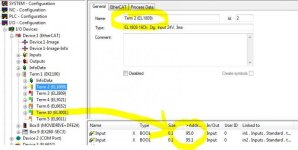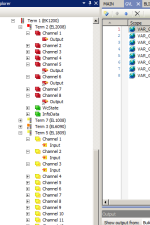kolyur
Lifetime Supporting Member + Moderator
Can the Beckhoff experts (I know there are a few of you out there) provide some suggestions on the best way to organize links to physical I/O?
I'm in the process of learning Twincat and figuring out variable linking. I know I can drill down through the devices in the I/O section to locate a particular input or output, then link it to a boolean variable. Would it make more sense to link to arrays, e.g. an 8-element BOOL array mapped to an 8-point input module? I'm thinking mainly of projects with high I/O counts where things could get messy real fast. On a similar note, is there any comprehensive way to see the existing links besides clicking on the individual I/O points or modules? It seems like there should be a column I can turn on in the Global Variable list that would show me the links, if any, for each variable--but I can't find any way to do this. What's the best way to keep track of links?
I'm in the process of learning Twincat and figuring out variable linking. I know I can drill down through the devices in the I/O section to locate a particular input or output, then link it to a boolean variable. Would it make more sense to link to arrays, e.g. an 8-element BOOL array mapped to an 8-point input module? I'm thinking mainly of projects with high I/O counts where things could get messy real fast. On a similar note, is there any comprehensive way to see the existing links besides clicking on the individual I/O points or modules? It seems like there should be a column I can turn on in the Global Variable list that would show me the links, if any, for each variable--but I can't find any way to do this. What's the best way to keep track of links?








